"Quark Soup" Cooking---Scientists from China, India and USA determine the phase transition temperature from normal matter to quark matter.
Scientists from China, India and USA determine the phase transition temperature from normal matter to quark matter.
In its infancy, when the universe was a few millionths of a second old, the elemental constituents of matter moved freely in a hot, dense, soup of quarks and gluons. As the universe expanded, this quark–gluon plasma quickly cooled, and protons and neutrons and other forms of normal matter formed: the quarks became bound together by the exchange of gluons, the carriers of the "color" force.
The theory that describes the "color" force is called quantum chromodynamics (QCD). At longer distances or at smaller momentum transfer, in bulk collections of matter including the quark-gluon plasma, an approach called lattice gauge theory has to be used.
Beginning in 2000, Relativistic Heavy Ion Collider (RHIC) located in Brookhaven National Lab (BNL),USA, was able to recreate the extreme conditions of the early universe in miniature by colliding massive gold nuclei at high energies. The high energy physics group of Department of Modern Physics in University of Science and Technology of China (USTC) designed the Multi-gap Resistive Plate Chambers (MRPC) based Time-Of-Flight detector for the STAR experiment. It significantly enhanced STAR particle identification capability.
Experimentalists at STAR/RHIC experiment in BNL working with theorist have recently compared lattice gauge theory predictions about the nature of the quark-gluon plasma with STAR' s experimental results on higher order fluctuations for the first time. In so doing they have established the temperature boundary where normal matter (known as hadronic matter) and quark matter cross over and change phase. Their results appear in the journal Science titled "Scale for QCD Phase Diagram of Quantum Chromodynamics". *

Derterming the Scale of the QCD phase diagram:(A) Comparison of experimental measurements with lattice gauge theory predictions and (B) the extract of phase transition temperature./COPYRIGHT by Authors.
Phase diagrams are maps, showing, for example, how changes in pressure and temperature determine the phases of water, whether ice, liquid, or vapor. A phase diagram of QCD would map the distribution of hadronic matter, the quark-gluon plasma, and other possible phases of QCD. Plotting a QCD phase diagram requires both theory calculations and experimental effort with heavy-ion collisions.
One of the basic requirements of any phase diagram is to establish its scale. A phase diagram of water might be based on the Celsius temperature scale, defined by the boiling point of water under normal pressure (i.e., at sea level). Although the boiling point changes with pressure – at higher altitudes water boils at lower temperatures – these changes are measured against a fixed value. The scale of the QCD phase diagram is defined by a transition temperature (expressed in units of energy) at the zero value of "baryon chemical potential". Baryon chemical potential measures the imbalance between matter and antimatter, and zero indicates perfect balance. Through extensive calculations and actual data from the STAR experiment, the team was indeed able to establish the QCD transition temperature.
The scientists were now able to proceed with confidence in establishing the scale of the QCD phase diagram. After a careful comparison between experimental data and the results from the lattice gauge theory calculations, the scientists concluded that the transition temperature is 175 MeV, about 2 trillion Celsius. At such temperatures atomic nuclei melt together into a soup of quarks and gluons, previously seen in the big bang with which the universe began.
In this paper, the authors compared experimental data with lattice calculations directly, something never done before. "This is a real step forward and allows us to establish the scale of the QCD phase diagram. This also begins an era of precision measurements for heavy-ion physics." says XU Nu of the U.S. Department of Energy' s Lawrence Berkeley National Laboratory (Berkeley Lab), the spokesperson for the STAR experiment.
Lattice gauge theory also predicts the existence of a "critical point". In a QCD phase diagram the critical point marks the end of a line showing where the two phases cross over, one into the other. Experiments at RHIC are currently searching for this point.
LUO Xiaofeng, who is the second author and the only student among the five authors, was an undergraduate of University of Science and Technology of China (USTC) from 2002 to 2006. He was recommended admission to Department of Modern Physics of USTC in 2006 to study for a doctoral degree under the supervision of Prof. LI Cheng,and specialized in heavy ion collision physics and equation of state of nuclear matter. During the period of his Ph.D related research, LUO has been the principal author of many papers on famous international physics journals, such as Phys. Rev. Lett., Phys. Lett. B and Phys. Rev. C, et al. LUO also studied in the Lawrence Berkeley National Lab from Feb. 2009 to Apr. 2011 as a joint training student, under the guidance of senior scientists Hans Georg Ritter and XU Nu.
*Science 332, 1525 (2011) : Sourendu Gupta, LUO Xiaofeng, Bedangadas Mohanty, Hans Georg Ritter, XU Nu.
W020110624539369842455.gif
Back
